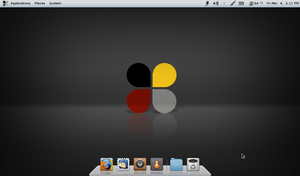Fuduntu
|
| |
|
Screenshot  A sample Fuduntu Linux desktop | |
| Developer | Fuduntu Team |
|---|---|
| OS family | Unix-like |
| Working state | Discontinued[1] |
| Source model | Mainly Open source and closed source |
| Initial release | 7 November 2010 |
| Latest release | 2013.2[2] / 8 April 2013 |
| Marketing target | General purpose; optimized for portable computers |
| Update method | Yum (PackageKit) |
| Package manager | RPM Package Manager |
| Platforms | IA-32, x86-64 |
| Kernel type | Monolithic (Linux) |
| Default user interface | GNOME |
| License | Mainly GNU GPL; various other free software licenses. For ease of use, some proprietary items are also included (e.g., Adobe Flash). |
| Official website |
www |
Fuduntu Linux was a Fedora-based Linux distribution created by Andrew Wyatt. It is designed to fit in somewhere between Fedora and Ubuntu (hence the name[3]), and, while optimized for netbooks and other portable computers, it is a general-purpose OS.
After forking Fedora 14 in early November 2011,[4] Fuduntu became an independent distribution and is no longer considered a "remix" of Fedora; it never qualified as a "spin" because it contained packages not included in Fedora.[5]
On a Team Meeting held on 14 April 2013, it was decided that Fuduntu would discontinue development and no new versions will be released. Large parts of the team were planning to work on a new rebased OS, most likely with a new name.[6]
On 28 April 2013 the Fuduntu website officially informed that the project has come to an end and that users may want to switch to the new project Cloverleaf Linux which is based on openSUSE instead.[7][8]
On 25 September, the developer team have decided to stop making Cloverleaf too, due to lack of manpower, as well as due to image leaks and other issues regarding source code for KDE's upcoming lightweight desktop environment KLyDE, which in term was supposed to be used as Cloverleaf's default desktop environment. Later, their blog went down.
Features
As Fuduntu was originally targeted at the Asus Eee PC and other netbooks,[9] it contains some tweaks to reduce power consumption. Among them, the /tmp and /var/log directories have been moved to RAM disk, and swappiness has been reduced to 10, to reduce the frequency of disk spin-up. In addition, Fuduntu includes the Jupiter power management applet (also developed by Andrew Wyatt), for easy adjustment of CPU performance settings, screen output and resolution, etc.
The default packages include Nautilus Elementary, Adobe Flash, the Fluendo MP3 Codec, VLC, Infinality Freetype, LibreOffice, and the nano editor.
Look and Feel
The used icon theme is called Faenza Cupertino. It features the distinctive square icon set of Faenza. Because it was originally based on Fedora and Ubuntu it has GNOME as window manager, giving the opportunity to change themes, including window frames.[10]
See also
References
- ↑ Fuduntu Linux is dead, bulk of team moves to Cloverleaf Linux project. Liliputing (2013-04-29). Retrieved on 2014-03-15.
- ↑ "Fuduntu 2013.2 Released". 2013-04-08.
- ↑ Fuduntu.org: Behind the Name
- ↑ Fuduntu 14.12 Release - Happy Anniversary!
- ↑ FedoraProject.org: Remix
- ↑ Fuduntu Team meeting held on 14 April 2013
- ↑ "Project Ends". Retrieved 29 April 2013.
- ↑ http://cloverleaf-linux.org/?p=16
- ↑ "Fuduntu Is A Fedora 14 Remix For Netbooks And Laptops ~ Web Upd8: Ubuntu / Linux blog". 2010-11-14. Retrieved 2011-08-15.
- ↑ Cristalinux.blogspot.com Review on Fuduntu 14.7